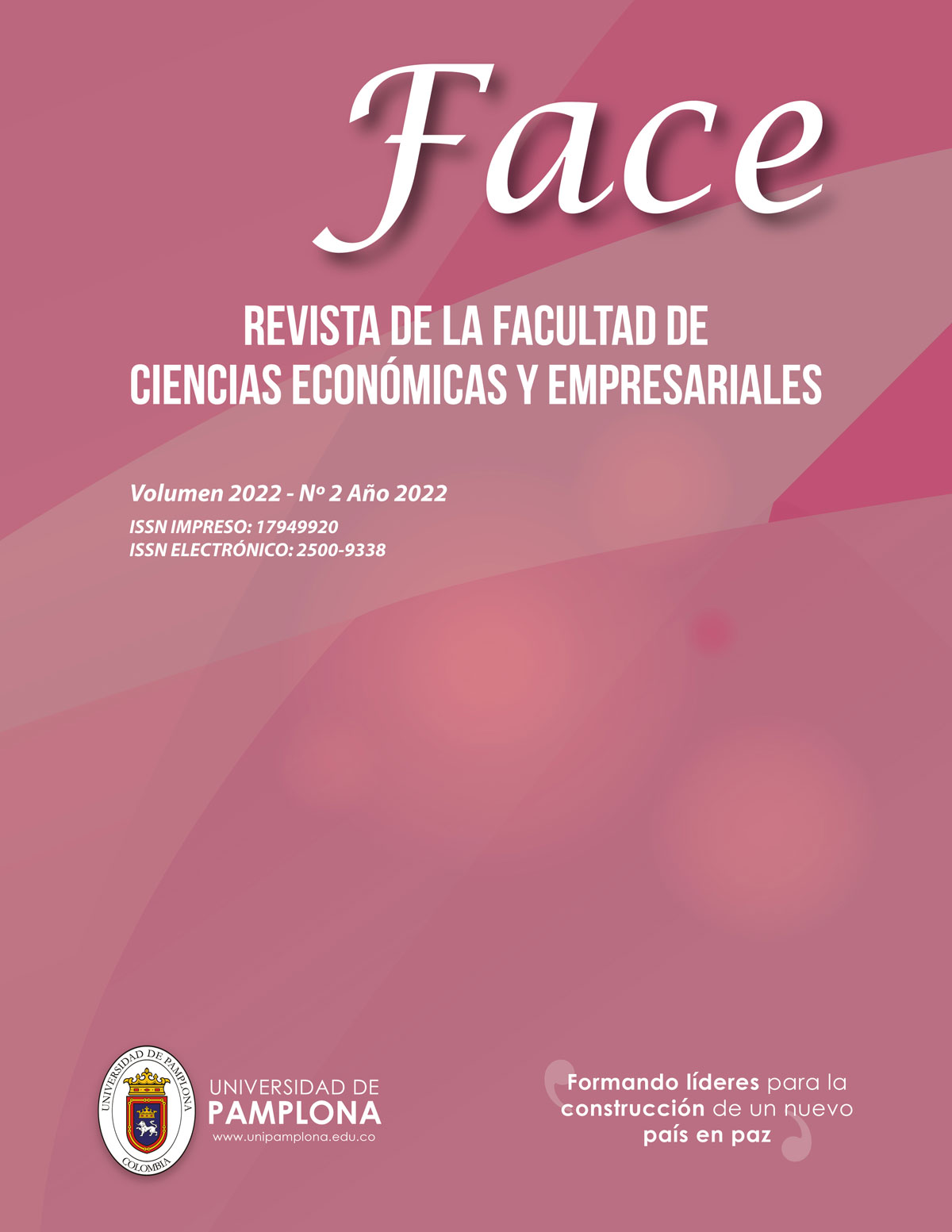El uso de las Tic y la percepción del consumidor en e-commerce
DOI:
https://doi.org/10.24054/face.v22i2.1325Palabras clave:
TIC, consumidor, e-commerceResumen
En esta investigación se analiza la influencia de la publicidad en las decisiones de compra a través del comercio electrónico. Se trata de un estudio cuantitativo de carácter exploratorio. Para ello, se diseñó un instrumento que se aplicó a una muestra no probabilística de 209 consumidores adultos que realizaron compras en línea antes y durante la pandemia. Los resultados indican que existe una relación entre los constructos de tecnología y promociones, mientras que no se encontró una relación significativa entre los constructos de tecnología y e-payment. Además, se observó que las mujeres tienden a valorar más la influencia de la publicidad.
Descargas
Referencias
Alderete, M. V. (2012). Medición de las Tecnologías de la Información y la Comunicación en empresas de servicios de Colombia, Cuadernos de Administración, 25(45),39–62. http://www.scielo.org.co/pdf/cadm/v25n45/v25n45a03.pdf
Bagnall, J., Bounieb, D., Huynhc, K. P., Kossed, A., Schmidte, T., Schuhf, S. y Stixg, H. (2016). Consumer cash usage and management: a cross-country comparison with diary survey data. International Journal of Central Banking, 46th issue. https://www.ijcb.org/journal/ijcb16q4a1.htm
Cabezas L. y Jara A. (2021) Demanda de dinero en efectivo: hechos estilizados y sustitución por medios de pago electrónicos. Revista de la Cepal35, 129-157. https://repositorio.cepal.org/bitstream/handle/11362/47708/1/RVE135_Cabezas.pdf
Chen, Z. T. y Cheung, M. (2020) Consumption as extended carnival on Tmall in contemporary China: a social semiotic multimodal analysis of interactive banner ads, Social Semiotics, 2-21. https://doi.org/10.1080/10350330.2020.1720992
Dubbelink, S.I., Herrando C., y Constantinides, E. (2021) Social Media Marketing as a Branding Strategy in Extraordinary Times: Lessons from the COVID-19 Pandemic, Sustainability, 13,10310, http://dx.doi.org/10.3390/su131810310
Grange, C., Benbasat, I. y Burton-Jones, A. (2018) A Network-Based Conceptualization of Social Commerce and Social Commerce Value, Computers in Human Behavior,108(2), 105855. https://doi.org/10.1016/j.chb.2018.12.033
Gu, S., Slusarczyk, B., Hajizada, S., Kovalyova, I., y Sakhbieva, A. (2021) Impact of the COVID-19 Pandemic on Online Consumer Purchasing Behavior. Journal Theor. Appl. Electron. Commer. Res,16, 2263-2281. https://doi.org/10.3390/jtaer16060125
Hu, X., Chen, X. y Davison, R. M. (2019) Social Support, Source Credibility, Social Influence, and Impulsive Purchase Behavior in Social Commerce, International Journal of Electronic Commerce,23:3, 297-327. https://doi.org/10.1080/10864415.2019.1619905
Jílkova, P. y Králová, P. (2021) Digital Consumer Behaviour and eCommerce Trends during the COVID-19 Crisis, Int Adv Econ Res, 27, pp. 83–85. DOI: https://doi.org/10.1007/s11294-021-09817-4
Jones, C., Motta, J, y Alderete, M. (2016). Gestión estratégica de tecnologías de información y comunicación y adopción del comercio electrónico en MiPyMEs de Córdoba, Argentina. Estudios Gerenciales,32 (2016) 4–13.
Matute, G., Cuervo, S., Salazar, S. y Santos, B. (2012). Del consumidor convencional al consumidor digital: el caso de las tiendas por departamento. Serie Gerencia Global22. Esan Ediciones. https://repositorio.esan.edu.pe/bitstream/handle/20.500.12640/88/Gerencia_global_22.pdf?sequence=1&isAllowed=y
Martínez, Á. M. y Fierro M., E. (2018) Aplicación de la técnica PLS-SEM en la gestión del conocimiento: un enfoque técnico práctico. Revista Iberoamericana para la investigación y el Desarrollo Educativo, Vol. 8, Núm. 16. https://doi.org/10.23913/ride.v8i16.336
Martínez, S. V. H., Maldonado, L. G., Casallas, M. D. P. J., & Ojeda, R. M. G. (2018). Capacidad dinámica de innovación como apuesta competitiva de valor empresarial.Gestión y Desarrollo Libre,3(5).https://revistas.unilibre.edu.co/index.php/gestion_libre/article/view/8194
Paredes, S. (2021) Rediseño del proceso de venta online en la empresa EQUUS para mejorar la gestión y los tiempos de entrega del canal ecommerce. Argentina: Universidad Nacional de San Martín, Escuela de Economía y Negocios, Tesis de grado. https://ri.unsam.edu.ar/handle/123456789/14%0914
Peña-García, N., Gil-Saura, I., Rodríguez-Orejuela, A., y Siqueira-Junior, J. R. (2020). Purchase intention and purchase behavior online: A cross-cultural approach. Heliyon,6(6), e04284. https://doi.org/10.1016/j.heliyon.2020.e04284
Koch, J., Frommeyer, B., y Schewe, G. (2020) Online Shopping Motives during the COVID-19 Pandemic—Lessons from the Crisis. Sustainability, 12(24), 10247. http://dx.doi.org/10.3390/su122410247
Ringle, C.M., Wende, S. y Becker, J.M. (2015) SmartPLS 3. SmartPLS GmbH, Boenningstedt. http://www.smartpls.com
Rossolov, A., Aloshynskyi, Y., y Lobashov, O. (2022). How COVID-19 Has Influenced the Purchase Patterns of Young Adults in Developed and Developing Economies: Factor Analysis of Shopping Behavior Roots. Sustainability, 14(2), 941. http://dx.doi.org/10.3390/su14020941
Sanabria, V. L., Torres, L. A. y López, L.M. (2016) Comercio electrónico ynivel de ventas en las MiPyMEs del sector comercio, industria y servicios de Ibagué. Bogotá, Pp.131-155. http://www.scielo.org.co/pdf/ean/n80/n80a10.pdf
Sehgal, R., Khanna, P., Malviya, M. y Mohan D., A. (2021) Shopping safety Practice Mutate consumer Buying Behaviour during COVID-19 Pandemic. Vision, pp.1-12. http://dx.dor.org/10.1177/09722629211010990
Vázquez-Martínez, U.J., Morales-Mediano, J. y Leal-Rodríguez, A.L. (2021) The impact of the COVID-19 crisis on consumer purchasing motivation and behavior. European research on management and business economics27, pp. 2-18. https://doi.org/10.1016/j.iedeen.2021.100166
Yeoman, I., Wheatley C., y McMahon-Beattie, U. (2016) Trends in retail pricing: A consumer perspective. Journal of Revenue and Pricing Management,17(4) pp.1-27. https://doi.org/10.1057/s41272-017-0093-1
Descargas
Publicado
Número
Sección
Licencia
Derechos de autor 2022 FACE: Revista de la Facultad de Ciencias Económicas y Empresariales

Esta obra está bajo una licencia internacional Creative Commons Atribución-NoComercial-CompartirIgual 4.0.





